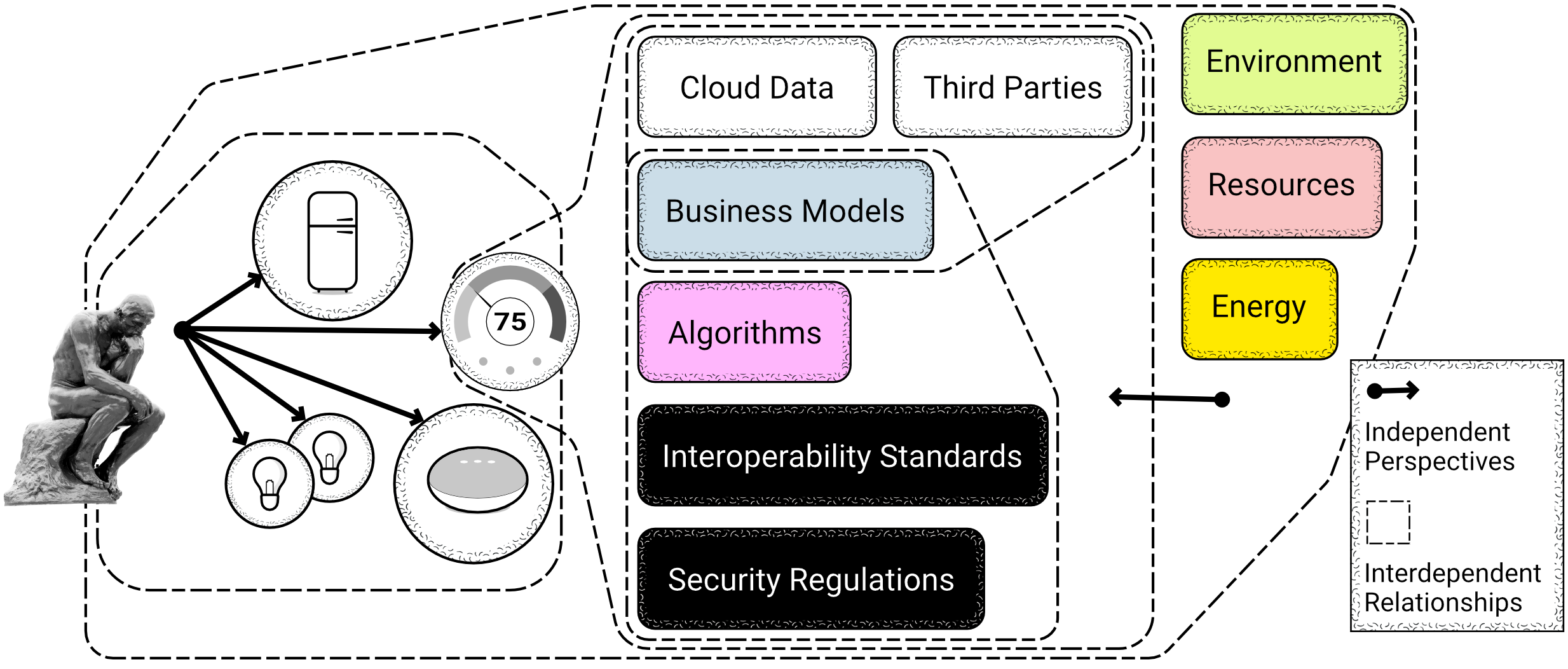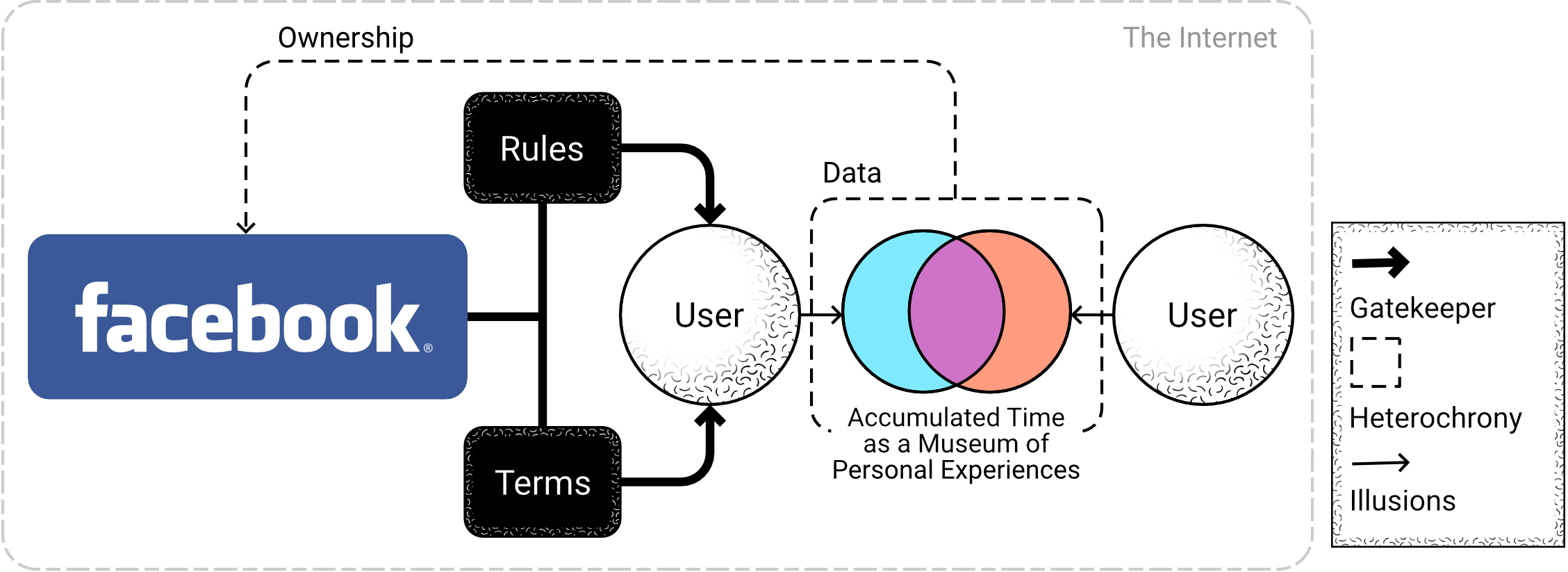Spatial Model for IoT
Seeing past the digital looking glass
“What is any ocean but a multitude of drops?”
David Mitchell, Cloud Atlas
Premise
This project attempted to establish a framework for understanding interactions within IoT. Though we accept that interactions with digital objects happen on the Internet, what exactly does that even mean? Where is the Internet? What kinds of interactions are these and what are their requirements? Furthermore, the only way we do any of this is by encountering non-digital objects like smart phones and laptops. Approaching these questions required dissecting digital and non-digital worlds towards making a spatial understanding encompassing the two. Explored through a philosophical lens of viewing digital spaces as experiential phenomenon for digital objects similar to the phenomenon of experience for non-digitals like ourselves and our world, this research unwraps IoT as if peeking through a metaphorical looking glass.Challenges
- Understanding parameters that define interactions within IoT.
-
Expanding on present established workings of IoT as spatial configurations.
- Establishing a phenomenological foundation for encounters with IoT.
Methodology
- Research through Design
-
Speculative Design
-
Object Oriented Philosophy
- Philosophical Carpentry
Background
Humans are social animals, we interact with not just people but also objects around us. Many of these interactions occur in multiple spaces—ones that have been defined over generations of meticulous arrangements. We move in and out of these ‘spaces’ as we navigate through our daily lives of interactions and encounters. Some spaces are very straightforward and have universal understandings such as a bedroom or a bathroom. But others are more fluid in nature, like the space within the pages of a notebook, or that within our thoughts. What’s more is many of these spaces exist within each other, and can even be influenced by their containers.This research began as an exploration in alternative modalities of thought towards the adoption of IoT1 specifically the spaces that create IoT, to understand what factors affect the presence of IoT for consumers. At the time early research into object-oriented-ness for design research was underway at Lancaster and as a thought experiment an object-oriented perspective was imagined in this instance. What if these objects of the Internet operated in their own capacity within the spaces they acknowledged as relating to their existence? Much like how as a human I understand the nuances of public and private spaces, what if these objects of the Internet did the same?
“The Internet does not exist…Because it has no shape. It has no face, just this name that describes everything and nothing at the same time.”2
The truth is that the Internet does not truly exist as a singular location, rather it is multiple points in an infinitely plottable existence; ironically not dissimilar to the expanding universe we occupy. Though the existential argument of the Internet-as-illusion similar to our reality-as-illusion is compelling, this research needed to focus on establishing how the Internet as a phenomenological space for digital objects may exist. The starting point being understanding what are these digital objects that create the many locations and points in the constellation of an otherwise shapeless Internet.
Constellations in a shapeless Internet
Since the Internet is not one singular place rather multiple locations coming together, thus our interactions within the Internet do not exist in a singular instance either. They are intercepted by factors out of our reach. Take for instance the humble smart home meter designed to simplify our lives by bringing at ease any horrors of central heating in the home. When you use a smart meter the immediate understanding is that you are controlling the heating in the house. In truth it is a much more complex arrangement being established. The heating is not in the house but coming from external providers, as is the electricity, and the Wi-Fi. The smart meter itself is not physically interacting with the heating elements of your house, it’s talking with other objects that might be. This talking is happening in the shapeless ether of the Internet but requires multiple hand-shakes with the established complex arrangements that make up that specific smart meter, in that specific setting of a home, in that specific location on the globe. These are agreements between stakeholders like your ISP, utility companies, the many servers the smart meter needs to interact with, laws of countries these interactions move through which it must obey, and so on. Our interactions with IoT is not necessarily as we assume, many interactions require further interdependent relationships to be formed.
Our interactions with IoT is not necessarily as we assume, many interactions require further interdependent relationships to be formed.It is a constellation of interactions existing as independent but interdependent relationships3 which for the most part remain unknown to us as users. Granted many of these interactions might not be of interest to us but some may, such as when digital objects decide to share our data without our consent. Just what are the agreements made between the different stakeholders after all?
From a design standpoint these interactions and arrangements are imagined from a human perspective, but the interactions occurring here are not with the human in mind. They are with ISP, private companies, or governments in mind. Furthermore, as a user your understanding remains a 1-1 relationship between yourself and the smart object. So how can design take into account this non-human perspective occurring within the Internet?
Philosophically speaking
To understand this alternative perspective this research explored Object-Oriented Ontology creating a phenomenologically parallel world to our own by working off established models of phenomenology.4 This approach is then augmented with a concept of heterotopias from Michel Foucault’s writings,5 to create an understanding of spaces within spaces existing with their own rules. By expanding on Harman’s four-fold model we establish a philosophical basis for digital phenomenology.
By expanding on Harman’s four-fold model we establish a philosophical basis for digital phenomenology.These spaces relate to each other. Take the space of a mirror image, it exists because there is something in the space in front of the mirror. Similarly the space occupied by the voice-on-the-phone exists because, somewhere, a person speaks into a telephone handset. Neither space can exist without the other, but they don’t always play nicely together. These interlinked spaces have their unique sets of rules and properties, and Foucault asked questions to try and understand what these are. For example, what is allowed to be experienced in a space and in what order, what circumstances dictate these experiences, and, most importantly, who gets to decide on all this?
Let’s imagine a museum. When you step inside there are rules that you must abide by; sometimes no photographs, no loud noises, etc. The museum allows you access to one sort of space, but the museum heterotopia also denies you access to another sort. Museum heterotopias don’t just manipulate space, but, in a sense, they twist time too. By providing a physical space for artefacts from the past, they create temporal illusions and transport the artefacts of the past into the audiences of the present. The timeless trinkets we see in museums create heterotopic rules that break up our understandings of space; although museums are public places, they allow for very private interactions between you, the artefacts, and other visitors in the space.
A Spatial Model for IoT
Technologies that work with objects of the Internet such as IoT have created a whole range of new heterotopias. Consider the smartphone, the text conversations you have, phone calls you make, and emails you send at first glance might appear to fit with commonly held conceptions of private spaces. However, if we consider that any message on your phone can be shared with anyone else through a screenshot the nature of this ‘private’ space changes. Facebook is excellent example of a heterotopia on the Internet that creates its own further heterotopias within it.6 Seeing Facebook as a heterotopia on the Internet manifesting further heterotopias within it.
Seeing Facebook as a heterotopia on the Internet manifesting further heterotopias within it. Inter-spatial model for interactions/encounters in IoT, each overlap defining a new heterotopia within digital/non-digital realities.
Inter-spatial model for interactions/encounters in IoT, each overlap defining a new heterotopia within digital/non-digital realities.Similar arguments around mediated publics7 come from the notion that social media complicates and blurs audiences and ideas of publicness affording alterations to public engagement within those spaces. In order to navigate these mediated spaces we must alter our behaviours allowing new controls and skills to form. The overlapping of digital/non-digital spaces and versions of private/public realities within them create unique heterotopias within them, each defining a new phenomenological reality. Amidst it all lies the interaction of our smart meters, jumping between heterotopia to heterotopia to converse with other objects of the Internet.
The framework established in this way approaches a similar construct by suggesting phenomenological object-spaces for digital objects and their interactions. These spaces are mediated just like social networks because through the object-oriented lens an object-geography is imagined. A social context collapse of digital/non-digital objects and their digital/non-digital spaces. To the digital objects the non-digital objects exist as equal to them on a level plane afforded by OOO. Because of this our interactions and the ways in which we must navigate them as both designers and user should be reimagined in favour of more meaningful design choices.
Research presented at
DRS2018, Limerick
In Journal Publication
Open Philosophy 2020
DRS2018, Limerick
In Journal Publication
Open Philosophy 2020
︎
- Lindley, Joseph, Paul Coulton, and Miriam Sturdee. ‘Implications for Adoption.’ In Proceedings of the 2017 CHI Conference, 265–77. New York, New York, USA: ACM Press, 2017. https://doi.org/10.1145/3025453.3025742.︎︎︎
- Arnada, Julieta, Brian Kuan Wood, and Anton Vidokle, eds. The Internet Does Not Exist. E-Flux Journal 9. Berlin: Sternberg Press, 2015. [Excerpt from book jacket]︎︎︎
- Lindley, Joseph Galen, and Paul Coulton. ‘On the Internet Everybody Knows You’re a Whatchamacallit (or a Thing).’ In CHI 2017 Workshop, 2017.︎︎︎
- Harman, Graham. The Quadruple Object. Winchester, U.K. Washington, USA: Zero Books, 2011.︎︎︎
- Foucault, Michel. Des Espace Autres (Of Other Spaces), Heterotopias. Architecture/Mouvement/Continuité, 1967. http://scholar.google.com/scholar?q=related:YOLKGE1nipgJ:scholar.google.com/&hl=en&num=20&as_sdt=0,5.︎︎︎
- Rymarczuk, Robin, and Maarten Derksen. ‘Different Spaces: Exploring Facebook as Heterotopia.’ First Monday 19, no. 6 (26 May 2014). http://firstmonday.org/ojs/index.php/fm/article/view/5006.︎︎︎
- Boyd, Danah. ‘Taken out of Context: American Teen Sociality in Networked Publics’. Dissertation, University of California, 2008.︎︎︎
